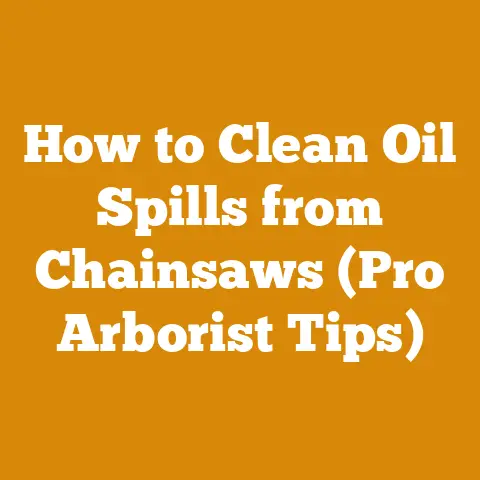FS76 Stihl Trimmer Repair Tips (5 Pro Fixes for Optimal Cuts)
The Craftsmanship of Optimal Cuts: Unveiling FS76 Stihl Trimmer Repair Secrets
There’s a certain satisfaction in the hum of a well-tuned Stihl trimmer, a feeling only rivaled by the clean, precise cuts it delivers. Whether you’re a seasoned landscaper, a dedicated homeowner, or somewhere in between, maintaining your FS76 Stihl trimmer is paramount to achieving those optimal cuts. Like any fine-tuned machine, these trimmers require care and attention, and sometimes, a little troubleshooting. In this guide, I’ll share five pro-level fixes that can breathe new life into your FS76, ensuring it continues to perform at its best.
5 Pro Fixes for Optimal Cuts with Your FS76 Stihl Trimmer
Let’s dive into some common issues and their solutions. Remember, safety first! Always disconnect the spark plug before performing any maintenance.
1. Fuel System Finesse: Cleaning the Carburetor and Fuel Lines
One of the most frequent culprits behind a sputtering or non-starting trimmer is a clogged fuel system. Over time, fuel can degrade, leaving behind varnish and deposits that gum up the carburetor and fuel lines.
The Problem: Stale fuel, dirty fuel filters, or blocked carburetor jets.
The Solution: A thorough cleaning.
- Fuel Tank Inspection: Start by draining the fuel tank and inspecting for debris. I once ignored this step and ended up chasing a phantom issue for an entire afternoon. A quick visual check can save you a lot of time.
- Fuel Line Check: Disconnect the fuel lines and check for cracks or clogs. Replace them if they’re brittle or damaged. Fuel lines are relatively inexpensive, and a new set can make a world of difference.
- Carburetor Cleaning: This is where things get a bit more involved. The carburetor mixes air and fuel to create the combustible mixture that powers the engine. Remove the carburetor carefully, noting the order of the linkages and gaskets. Use a carburetor cleaner spray to thoroughly clean all jets and passages. A small wire or carburetor cleaning tool can help dislodge stubborn deposits.
- Fuel Filter Replacement: Always replace the fuel filter when cleaning the fuel system. It’s a cheap insurance policy against future clogs.
Cost Breakdown (Fuel System):
- Fuel Filter: $3 – $7
- Fuel Line Set: $5 – $12
- Carburetor Cleaner: $5 – $10
- Carburetor Rebuild Kit (Optional): $15 – $30 (If the carburetor is severely damaged or worn)
Pro Tip: When reassembling the carburetor, refer to a diagram or take pictures during disassembly to ensure everything goes back in the correct order. A misplaced gasket can cause leaks and performance issues.
2. Ignition System Investigation: Spark Plug and Ignition Coil Check
If the fuel system is clean but the trimmer still won’t start, the ignition system is the next place to investigate. The spark plug creates the spark that ignites the fuel-air mixture, and the ignition coil provides the necessary voltage.
The Problem: Fouled spark plug, weak spark, or faulty ignition coil.
The Solution: Testing and replacement.
- Spark Plug Inspection: Remove the spark plug and inspect it. A healthy spark plug should have clean electrodes and a light tan color. If it’s black, oily, or heavily worn, it’s time for a replacement.
- Spark Test: Reconnect the spark plug to the spark plug wire and ground the plug against the engine block. Pull the starter cord. You should see a strong, blue spark. If the spark is weak or nonexistent, the ignition coil may be the culprit.
- Ignition Coil Testing: Use a multimeter to test the resistance of the ignition coil. Compare the reading to the specifications in the FS76 service manual. If the resistance is outside the specified range, the ignition coil needs to be replaced.
Cost Breakdown (Ignition System):
- Spark Plug: $3 – $8
- Ignition Coil: $20 – $50
- Spark Plug Tester (Optional): $10 – $20
- Multimeter (If you don’t already own one): $20 – $50+
Pro Tip: When installing a new spark plug, use the correct torque setting (typically around 10-12 ft-lbs). Over-tightening can damage the cylinder head.
3. Air Filter Attention: Maintaining Clean Airflow
A clean air filter is crucial for proper engine performance. A clogged air filter restricts airflow, leading to a rich fuel mixture, reduced power, and increased fuel consumption.
The Problem: Dirty or clogged air filter.
The Solution: Regular cleaning and replacement.
- Inspection: Remove the air filter and inspect it. If it’s visibly dirty, it needs to be cleaned or replaced.
- Cleaning: If the air filter is foam, wash it with warm, soapy water, rinse thoroughly, and allow it to dry completely. If it’s paper, gently tap it to remove loose debris. Do not use compressed air, as this can damage the filter.
- Replacement: Replace the air filter if it’s damaged or excessively dirty.
Cost Breakdown (Air Filter):
- Air Filter: $5 – $10
Pro Tip: Check the air filter regularly, especially in dusty conditions. A clean air filter can significantly extend the life of your engine. I’ve seen engines fail prematurely simply due to neglected air filters.
4. Recoil Starter Revival: Repairing a Broken Starter Cord
A broken starter cord can bring your trimming to a screeching halt. Fortunately, replacing a starter cord is a relatively straightforward repair.
The Problem: Broken or frayed starter cord.
The Solution: Cord replacement.
- Disassembly: Carefully disassemble the recoil starter housing, noting the position of the spring and other components.
- Cord Removal: Remove the broken starter cord from the pulley and handle.
- Cord Installation: Install the new starter cord, ensuring it’s properly routed through the pulley and handle.
- Reassembly: Reassemble the recoil starter housing, being careful to pre-tension the spring correctly. This is often the trickiest part. There are numerous online tutorials that can guide you through this process.
Cost Breakdown (Recoil Starter):
- Starter Cord: $3 – $8
- Recoil Starter Assembly (If the entire assembly is damaged): $20 – $40
Pro Tip: When replacing the starter cord, use a high-quality cord that is resistant to wear and tear. This will help prevent future breakage. I prefer using a cord with a braided construction for added durability.
5. Trimmer Head Troubleshoot: Line Feeding Issues
A properly functioning trimmer head is essential for efficient trimming. If the trimmer line isn’t feeding correctly, it can slow you down and make the job more difficult.
The Problem: Trimmer line not feeding, line breaking frequently, or trimmer head jammed.
The Solution: Inspection, cleaning, and line replacement.
- Inspection: Remove the trimmer head and inspect it for debris or damage.
- Cleaning: Clean the trimmer head thoroughly, removing any dirt, grass, or other debris.
- Line Replacement: Replace the trimmer line with the correct diameter and type for your FS76. Using the wrong line can cause feeding problems.
- Spool Winding: Wind the trimmer line evenly onto the spool, following the manufacturer’s instructions. Uneven winding can cause the line to tangle and break.
Cost Breakdown (Trimmer Head):
- Trimmer Line: $5 – $15 (depending on the length and type)
- Trimmer Head Replacement (If the head is damaged): $15 – $40
Pro Tip: Soak the trimmer line in water for a few hours before winding it onto the spool. This will make the line more flexible and less likely to break. I’ve found this especially helpful in hot, dry climates.
Global Cost Considerations for Maintaining Your FS76 Stihl Trimmer
The cost of maintaining your FS76 Stihl trimmer can vary significantly depending on your location. Here’s a breakdown of some key factors:
- Part Availability: In some regions, genuine Stihl parts may be readily available and competitively priced. In others, you may need to rely on aftermarket parts, which can vary in quality and price.
- Labor Costs: If you choose to have a professional repair your trimmer, labor costs will vary depending on the hourly rate of local mechanics. In developed countries, labor costs can be significantly higher than in developing countries.
- Currency Exchange Rates: Fluctuations in currency exchange rates can affect the cost of imported parts.
- Shipping Costs: If you need to order parts online, shipping costs can add significantly to the overall cost.
To illustrate this, let’s consider a simple example: replacing a fuel filter.
- United States: A genuine Stihl fuel filter might cost $5, and shipping could be around $5. Total cost: $10.
- Europe: A genuine Stihl fuel filter might cost €5, and shipping could be around €5. Total cost: €10 (approximately $11 USD).
- Developing Country (e.g., India): An aftermarket fuel filter might cost ₹200 (approximately $2.50 USD), and shipping might be minimal if purchased locally. Total cost: $2.50.
These are just rough estimates, but they highlight the potential cost differences.
Budgeting for FS76 Stihl Trimmer Maintenance
Creating a budget for your FS76 Stihl trimmer maintenance can help you avoid unexpected expenses and keep your trimmer running smoothly. Here’s a suggested approach:
- Annual Inspection: Plan for an annual inspection and tune-up. This should include cleaning the air filter, inspecting the spark plug, and checking the fuel lines.
- Parts Replacement Fund: Set aside a small amount of money each month for potential parts replacements. A good rule of thumb is to budget 5-10% of the trimmer’s purchase price per year.
- Contingency Fund: Create a small contingency fund for unexpected repairs.
- DIY vs. Professional Repair: Decide whether you’ll handle repairs yourself or hire a professional. DIY repairs can save you money on labor costs, but they require time and skill.
Cost Optimization Tips
Here are some practical tips for optimizing the cost of maintaining your FS76 Stihl trimmer:
- Preventive Maintenance: The best way to save money on repairs is to perform regular preventive maintenance. This includes cleaning the air filter, inspecting the spark plug, and using fresh fuel.
- Bulk Purchases: Consider buying consumable items like trimmer line and fuel filters in bulk. This can often save you money in the long run.
- Aftermarket Parts: While genuine Stihl parts are generally of higher quality, aftermarket parts can be a more affordable option. Just be sure to research the brand and read reviews before purchasing.
- Online Resources: Utilize online resources like YouTube tutorials and online forums to learn how to perform basic repairs yourself.
- Local Repair Shops: Shop around for the best prices on professional repairs. Get quotes from multiple repair shops before making a decision.
- Proper Storage: Store your trimmer properly during the off-season to prevent damage and corrosion. Drain the fuel tank and store the trimmer in a dry, protected area.
The Sweet Sound of Success
Maintaining your FS76 Stihl trimmer doesn’t have to be a daunting task. By understanding the common issues, implementing these pro-level fixes, and budgeting wisely, you can keep your trimmer running smoothly for years to come. Remember, a little preventative maintenance goes a long way. Now, go forth and achieve those optimal cuts!
Actionable Takeaways and Next Steps
- Schedule a maintenance check: Inspect your FS76 Stihl trimmer’s fuel system, ignition system, and air filter.
- Create a budget: Allocate funds for routine maintenance and potential repairs.
- Gather resources: Bookmark helpful online tutorials and identify local repair shops.
- Stay informed: Keep up-to-date with maintenance tips and best practices for your FS76 Stihl trimmer.
By taking these steps, you’ll be well-equipped to keep your FS76 Stihl trimmer in top condition and enjoy years of reliable performance. Happy trimming!






